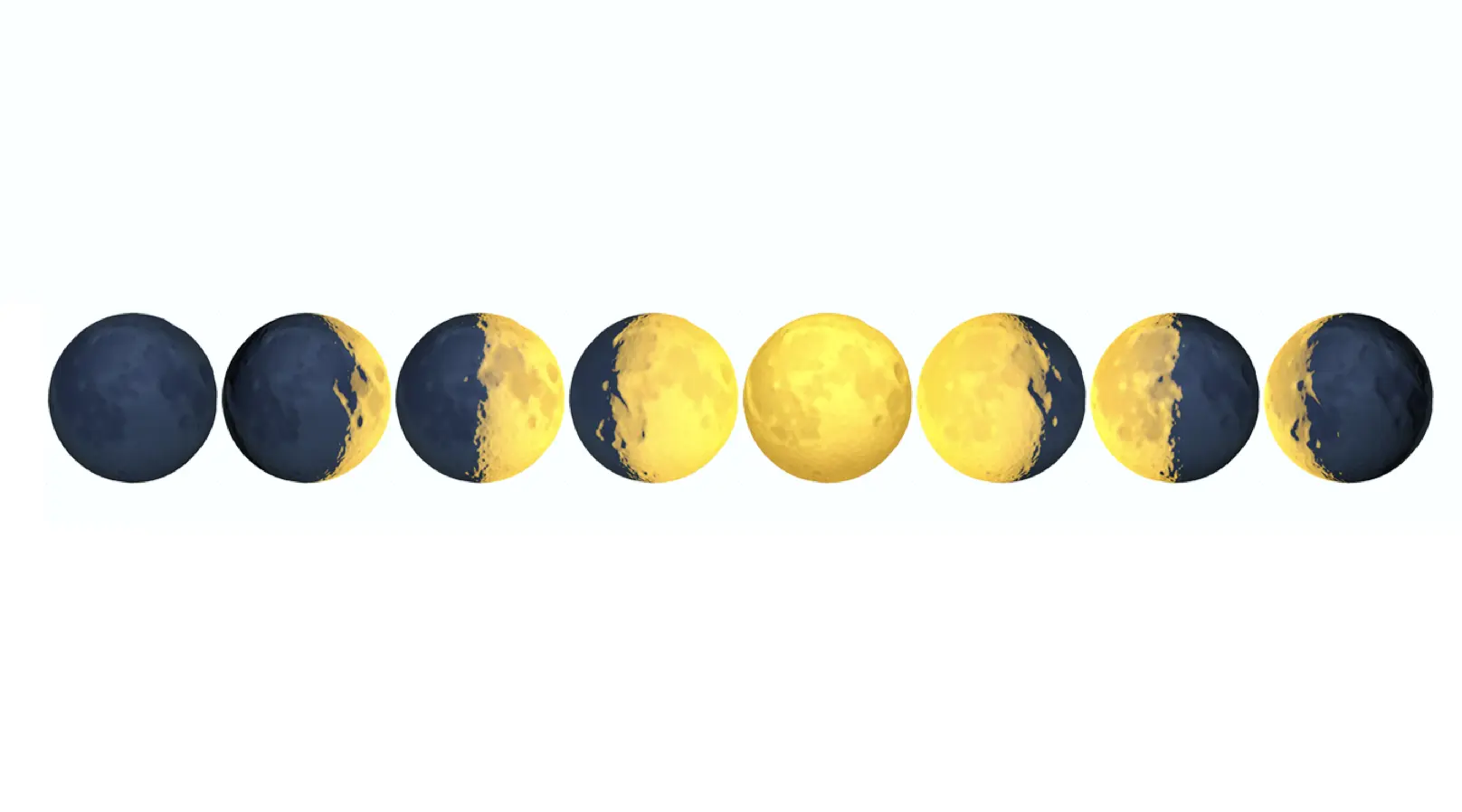
In mid-November 2024, the phase of the moon is a full moon 🌕, as it is represented by an emoji. If you’re wondering, what is the current phase of the moon as an emoji, this celestial event answers it perfectly. During this phase, we can see the full circle in the sky, making it one of the most fascinating sights. The full moon occurs when the Earth is positioned between the Sun and the Moon, fully illuminating the lunar surface. This phase is associated with increased nighttime brightness and holds significant cultural importance in various rituals.
Understanding moon phases in Lunar Calendar
The following moon phases exist in the Lunar Calendar in Lunar calendar due to their different positions between the Earth and the Sun:
1. New moon (🌑): When the moon positions itself between earth and sun its bright side faces away from us and it is invisible due to our eye view. This positioning represents a new phase of moon in which its dark side is facing us.
2. Young moon (🌒): As the moon progresses in its orbit, moving away from its alignment with sun, a thin curve becomes visible from earth.
3. Half moon (🌓): A half moon is visible, creating a half-circle.
4. Almost full moon (🌔): Approaching its fullness, more than half of the moon is illuminated.
5. Full moon (🌕):This phase is occurs when earth is between the moon and sun, allowing the fully lighting side of moon facing us.
6. Waning moon (🌖):The illumination begins to decrease after full moon.
7. Last quarter (🌗):This phase occurs after three weeks of full moon.
8. Old moon (🌘): As the moon approaches the new phase, a reducing rounded shape becomes visible, making the last stages of its life cycle.
These emojis provide a visual representation of the moon’s phases, represented to educate the phases.
Popular moon phase emoji trend in Australia
Australians use moon emojis in various creative ways in social media and also in texting. There are some trends that are followed by Australians:
- Full moon celebration: Australians mostly celebrate full moon celebration in regards to wellness and manifestation. The full moon emoji 🌕 often appears on their social media account.
- Zodiac and star sign updates: Astrology enthusiasts often post about new moon, or half moon to mark significant Lunar phases.
- Night time selfies and photography: Photographers especially use young or waning moon emojis to caption the sky image, capturing the particular stages of the moon.
Use of moon phase emoji in digital communication
Different types of moon-phase emoji are used for different occasions:
1. Celebrating achievements: For celebrating big achievements in life, use full moon emoji 🌕.
2. Encouraging others: For appreciating or encouraging others, use this emoji 🌘.
3. Accepting evolutions: Last quarter tells the transitions or end of the chapter.
4. Meditation: For a moment of self care waning crescent 🌘 is especially popular on social media.
Combination of emojis showing Lunar eclipse
In this way Lunar cycle represents in emoji way 🌑🌒🌓🌔🌕🌖🌗🌘,this sequence visually represents the phases of moon, further this sequence helps to understand the basic information about Lunar cycle.
Moon phases are meaningful in Australia
In numerous native cultures, the moon is picturized and characterized prominently in dreamy stories that convey moral lessons, cultural values and natural phenomena. Among the Yolngu people of Arnhem, the moon is called Ngalindi because a man who becomes thinner day by day after being punished by his wife, represents the old moon phase of the moon.
Applications in the environment and practical fields
Beyond cultural narratives, the lunar phases provide useful direction for many kinds of activity:
- Fishing and hunting: Because animal behavior often follows lunar cycles, certain phases of the Moon correspond to the best periods for these activities.
- Agriculture: Planting and harvesting plans are sometimes timed to correspond to lunar phases, demonstrating an awareness of environmental cycles.
- Navigation and timekeeping:The Moon, like other celestial bodies, has long been used as a natural calendar to mark the passage of time, seasonal changes, and navigation.
Modern Relevance
The relevance of the Moon’s phases is still appreciated in numerous ways:
- Cultural revitalization: Teaching and celebrating lunar lore and applications is part of the cultural revitalisation of Indigenous knowledge systems.
- Astronomical Education: Resources and efforts demonstrate Indigenous Australians’ extensive understanding of astronomy, fostering respect and enthusiasm for this subject of study.
Conclusion
Currently, in mid-November the moon is full just like an emoji🌕 but its phases changes with the passage of time, Australians have different types of occasions for every moon phase to celebrate every joy of life. Moon has its importance due to its viewers and its calmness gives people a sigh of relief in nights from their hectic routine, moon phases also have different meanings for people to follow it in different occasions like to marry or celebrate.







